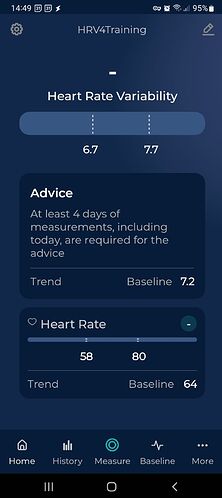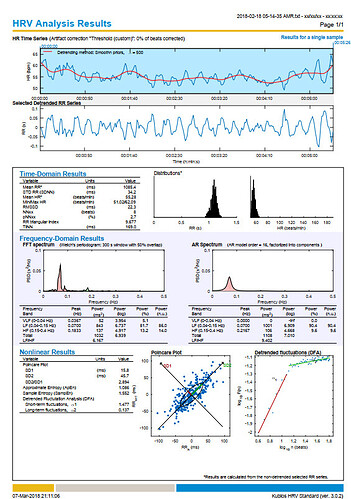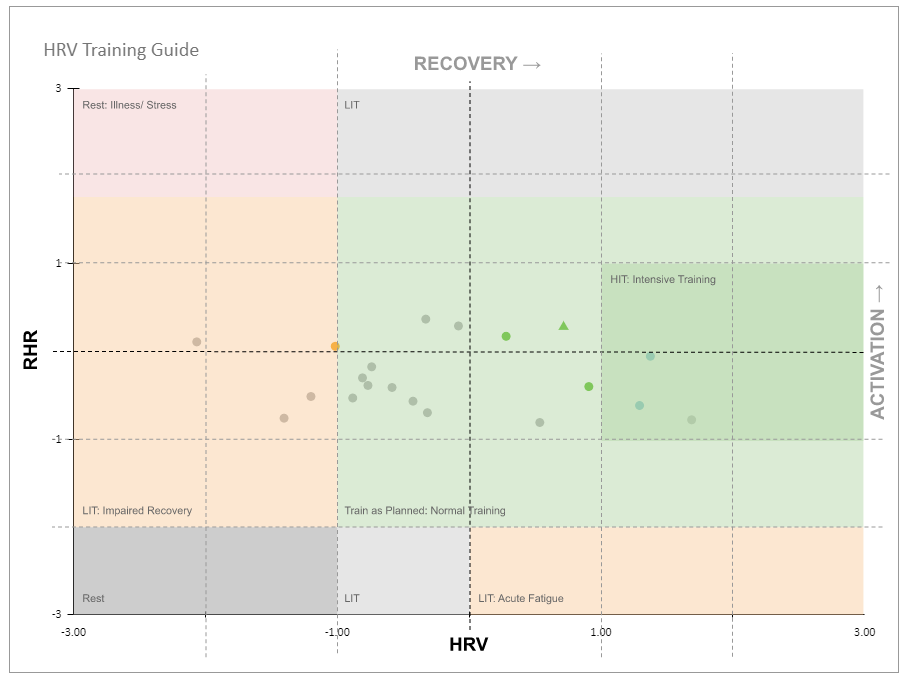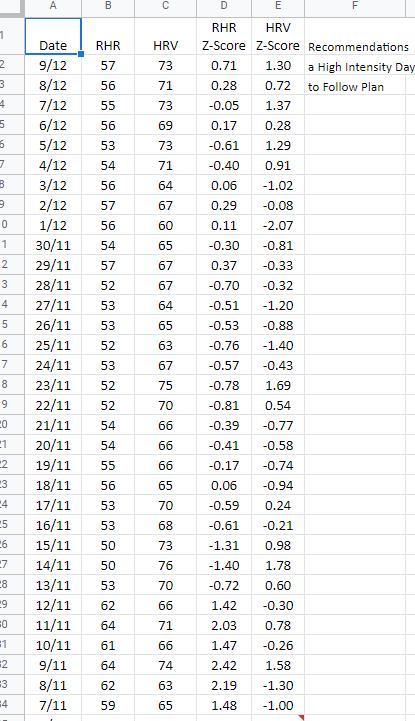Ah. Interesting last line there. I wasn’t aware of that. I’ll pop that into Kubios and see the the ratio is.
Kubios also calculates SDNN differently.
Kubios removes low frequency trend component (which is not associated to nervous system activity) from the RR-series before the HRV analysis.
I’m going to be frank and straightforward but, by all means, I don’t want to offend you or anyone else.
By moments I feel uncomfortable by the depth and detail of your questions regarding HRV.
Please understand that we, or it least I, am not an expert at this. I’m just someone who is very interested in anything that has to do with HRV. I carefully take the time to evaluate sources of info, I’m reading for hours and I’m trying to understand as much as possible, just because I like to do that (nerd??  ,-) ) But the only reference I have to evaluate in practice, is my own data. I’m trying to provide toole and insights, but I can only refer to other much more knowledgeable people who have done tons of research.
,-) ) But the only reference I have to evaluate in practice, is my own data. I’m trying to provide toole and insights, but I can only refer to other much more knowledgeable people who have done tons of research.
For personal advice, historical results are just as important as the outcome of whatever tool available right now. And, as you state yourself, subjective feelings remain the top priority to listen to.
My general take on this is to carefully document any ‘unusual’ result and how I reacted and responded on that reaction. Given the outcome, I will react the same or totally different the next time I see such a result. But it’s not because something works out good or bad for me that you will respond in the same way.
My ‘mantra’ is quite simple: when in doubt, take it easy! There is way more to loose when doing to much at the wrong time, then when keeping it simple and easy for that one session. Always look at long term profits/deficits. What’s the value of one session in a multi-year plan?
Last line of your post - Agreed. Absolutely zero value when you take the long term approach.
This is just a discussion forum. We’re all trying to find out a bit more and build our knowledge base. We all read about HRV and try to learn about it. This forum is just another source of information.
I’m only asking questions. Nobody needs to or should feel uncomfortable about them. They’re not personal.
All I asked this morning was how can we use SDNN, LF and HF to make a more informed decision. Nothing more, nothing less. Clearly rMSSD analysis alone as is used by Altini and EliteHRV, and others I’m sure, doesn’t cut the mustard at times. Generally they’re good apps but sometimes they’re lacking.
We can all do our own research but we can also share what we know here (or what we think we know!). It’s what forums like this are for.
My question this morning was intended as a reply to @Luisma_Gallego_Soy_P post directly above it. It wasn’t designed or intended to make @MedTechCD or anyone else uncomfortable and I don’t really see how it could. But anyway, back to the HRV discussion and let’s all try gain a bit more insight 


I personally don’t feel bad about the questions, I am currently a senior technician in physiology and I have been researching and specialising in HRV for quite some time, luckily in this case I do have a fairly large number to be able to see what happens with all the values, but it is something very personal and you have to take into account the feelings of the athlete, in my experience (and I have discussed this with Marco Altini several times) using only the rMSSD can lead to confusion, the tool that has been shared here is brutal and I personally use it for my studies and tests and to evaluate with more HRV metrics.
Three days ago I was negative in Covid after 8 days in a row, this time it has affected my cardiorespiratory level and I am really tired, the HRV parameters are correct because I really have nothing, but my perceptions are not good, the problem is that I have two covids in 20 days so my baseline has changed and it is something to evaluate, because probably although I have no covid, having taken it twice in a row the hrv has not managed to return to its baseline of origin. By this I mean that you have to evaluate everything, know the evolution of the athlete and know his current and previous state in order to then make the right decisions.
Before covid
After 2 covid
Another case where you have to value the feelings of the athlete, look at how the hrv is today, with these values maybe the session he has to do today would not be the best, but we always contextualise everything, we simply look at the time the athlete trained yesterday and we see that he trained at 19:21 and today he woke up to work at 06:00 so these values mean that he has not recovered from the previous day, if we do not look at these small details, being guided by the hrv would lead us to error.
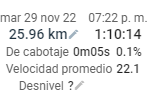
I hope you get better soon. It can be an awful dose to get.
Had COVID twice myself, in March and July this year. I was over the March infection in 5 weeks but I am still not over the July one. This awful feeling in my throat still and often a gagging sensation. HR still v high during exercise, especially in the true bona fide aerobic zones (Z1 and low Z2 in 5 zone model). And the exhaustion is unbelievable at times. I could go on and on but will leave it at that 
Was also reading that that in order to get a valid LF reading the measurement needs to be at least 4 minutes long. I don’t take 4 minute measurements. I take 1 minute ‘stabilisation’ time followed by 2 minutes measuring. Consequently I don’t think I can really pay too much attention to LF / HF ratio.
EliteHRV (the app I use) also calculates SDNN differently to Kubios, who remove low frequency trend components before analysis.
I’m not sure which SDNN value is more accurate (although assuming from above that it has to be Kubios).
That leaves me with rMSSD and my own subjective feelings.
+1, h10 drain battery if you start doing hrv test
I replaced the H10 battery 3 weeks back, the OEM one, and got 315 hours use from it. 235 activities and daily HRV reading.
Will be interesting to see how long the replacement (Duracell) will last. My Garmin HRM-Tri would last about a third of the OEM battery.
Interesting. I could never get more than 100 hours from my H9 battery. That sensor failed after about a great (under warranty though) and a new one was sent to me. Now I just use the H9 for HRV only and my Tickr for workouts.
I use HRV4Training, but it seems to be a bit unwieldy - if you miss a day, then the measuremants have to be started again (at lesast four consecutive days are required). Also you have to keep rmembering what day (for example ) the 24th of last moth was - I prefer seeing actual days listed as well as dates as my work schedles are kind of odd. Also my HR Monitor stopped working with it but kept on with two other apps, one if which I would highly recommend: Kubios. They also do a (free, but you need to register) PC version wich is incedibly detailed - I had a doctor look at my info recently and they were very impressed, and we managed to see various health issues and their impact on my training, recovery, and activities. a low score just means take it easier that day, as opposed to doing nothing - I think my lowest was 12%, several 25’s. Several low ‘scores’ over several weeks I had during October coincided with me being really ill and now just being two days out of 10 days in hospital!! Scores are back up ie HR 58bpm, RMSSD 22ms, and '80% Readiness" showing, but I still feel like …ugh!
I haven’t found that and I’ve been using it for over 2 years. The odd missed day doesn’t matter. It’s if you miss enough so that the 7 day average (baseline) becomes meaningless that you have to have some consecutive days to reset it.
It’s important to disconnect one of the contacts after use or the H10 suffers from bad battery drain.
On my screen right now -
“Advice
At least4 days of measurements, including today, are required for the advice”
With an rMSSD of 22 it is clear that something is going on, all this needs interpretation and using subjective perceptions as a guide as well, the interpretation of the HRV is not just based on one piece of data, but on a set of data, we think it is easy and simple but it requires knowledge and how the whole system works to be able to make concrete decisions.
It is totally normal that several measurements are required, even 4 is not enough, I prefer 15 days where we create a more coherent baseline.
Agreed, hence my suggestion use of the (Kubios App, and then the) PC program - during October, I would have had to have started againa and again so many times! Nb- I did just get out of hospital after 10 days - I knew ther was something wrong :-), especially then!
All good, now!!
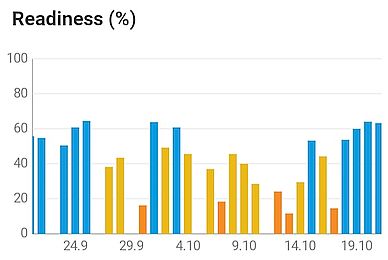
Been measuring my HRV since 2016 (HRV4, Elite, Kubios and some fairly esoteric ones HRVAS, Kardia etc - all info went into Golden Cheetah at the time). I’m no expert but I can spot long patterns and my doc trusts me enough that I can send a few screenshots, if I think I’m actually ill as opposed to just tired - also there’s no info given for 'did I drink/ travel etc) - it’s just how my body felt on the day, regardless. I did used to do measurements through the night, whilst drivinf etc…they were always fun.
You must have missed 3 in a 7 day period. As I said missing one occasionally shouldn’t be a problem in the grand scheme of things



